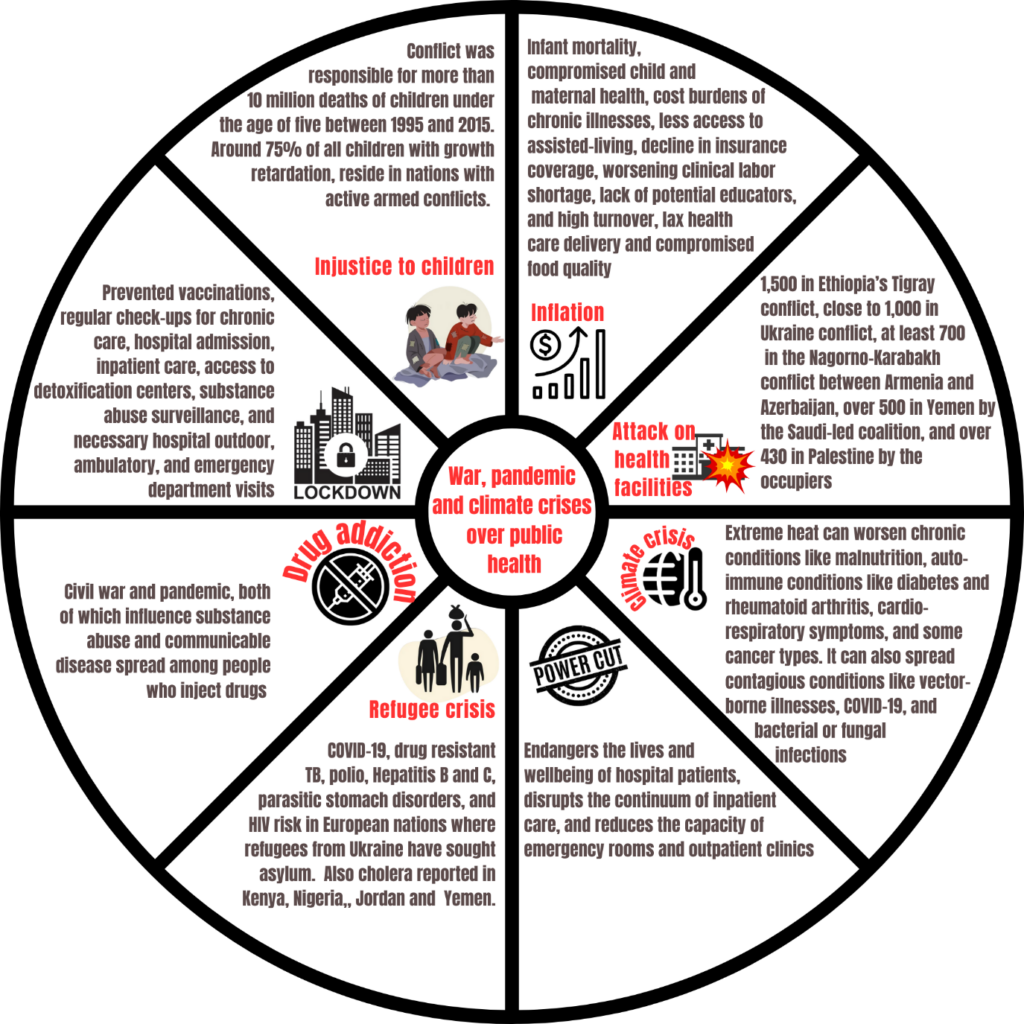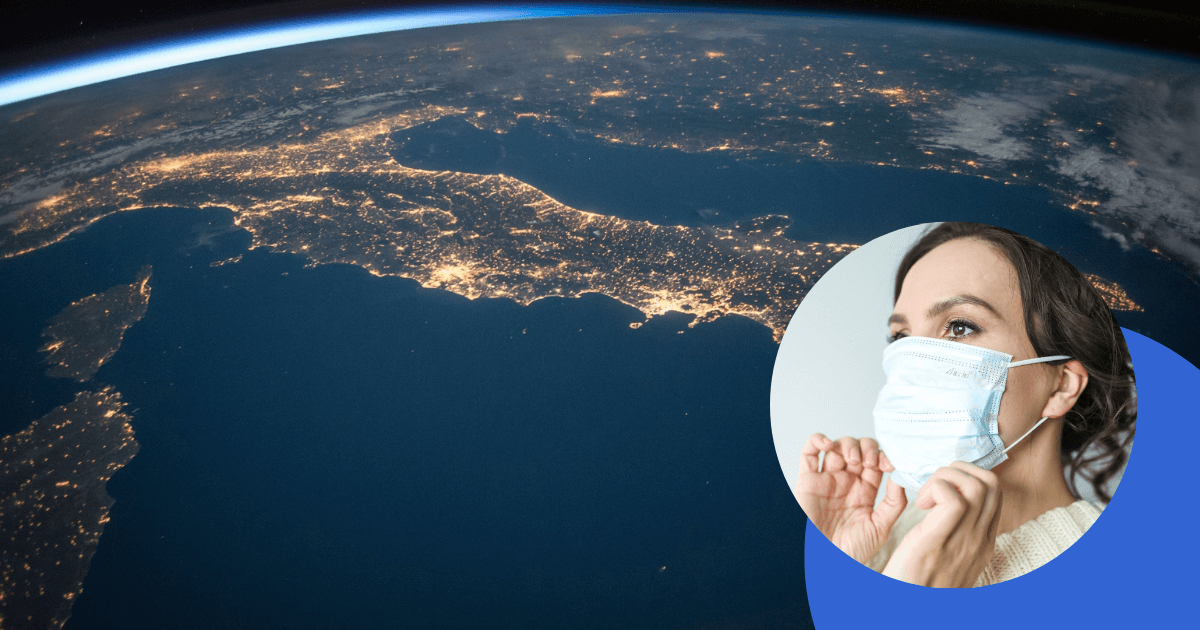Over 50 years, the Global Terrorism Database (GTD) discovered terrorist attacks in 61 different countries’ health facilities, with more than 50% of cases targeting medical personnel.
Currently, humanity is facing a serious crisis. The contraction of the world economy, the sharp decline in the value of financial assets, the collapse of imports and exports, the contraction of industrial production, the increase in inflation, the decline in money wages, the increase in unemployment, the decline in social security due to many natural disasters, the displacement of people due to epidemics and the constant competition that destroy not only the economic sector but also the health sector. The ripple effects of war, pandemics and natural catastrophes began at a time when 1 in 16 people worldwide was just pushed into extreme poverty due to healthcare costs, 1 in 4 had already been denied access to essential medicines, and 1 in 2 lacked access to essential health services. And now, deaths due to climate shock are 30 times higher than they were 20 years ago, and hunger is killing a life every 4 seconds. Additionally, because more or less half of the world’s population lacks adequate health literacy, the general public may have the hardest time understanding these issues.
Inflationary hiccups include food and energy crises, currency weakening and stagnating business, as well as 41-year highs in the US and UK; 40-year highs in Japan and Germany; 37-year highs in France and Italy; 30-year highs in India and New Zealand; and 24-year highs in South Korea, Thailand and Turkey. Healthcare will be less concentrated if the food crisis, inflation, and economic stagflation prevail. Spending on medical and health care generally rises more quickly than overall inflation. In addition, higher inflation is linked to increased infant mortality rates, deteriorated maternal and child health, higher hospital worker shortage, costs per patient, depression, anxiety, grief, and stress, the economic burden of chronic ailment, less access to care facilities and separate habitation for the older population, low-income families affecting quality of the food, diminished medical insurance, a growing clinical and a lack of potential medical talent.
The pandemic, the trade war between the United States and China, and the Ukraine crisis all threaten the global supply chain for medical equipment and raw materials.
Conflicts were to blame for more than 10 million child deaths worldwide between 1995 and 2015. 80% of all needs for humanitarian assistance are impacted by conflicts. Up to two-thirds of the world’s extremely poor people will reside in unstable and violently unstable regions by the year 2030. According to the 2018 World Innovation Summit for Health, 60% of the world’s chronically malnourished and starving people, including 75% of children worldwide with growth retardation, live in countries where armed conflicts are still raging. Over 50 years, the Global Terrorism Database (GTD) discovered terrorist attacks in 61 different countries’ health facilities, with more than 50% of cases targeting medical personnel. According to the WHO, 70% of all assaults on medical facilities worldwide in 2018 happened in Syria. The devastation of health facilities has also been reported, including 1,500 in Ethiopia’s Tigray conflict, close to 1,000 in the Russia-Ukraine conflict, at least 700 in the Nagorno-Karabakh conflict between Armenia and Azerbaijan, over 500 in Yemen by the Saudi-led coalition, and over 430 in Palestine by the occupiers. Additionally, Europe is at higher risk of COVID-19, drug-resistant TB, polio, Hepatitis B and C, parasitic stomach disorders, and HIV, which are more prevalent in European nations where refugees from Ukraine have sought asylum.
According to the UNHCR’s refugee data finder, there were more than 100 million people worldwide who were displaced for various reasons, and 32.5 million people who were refugees as of mid-2022. It’s also been reported that cholera is spreading among the displaced Yemeni people and Syrian refugees living in Jordan. Conflict elevated the likelihood of cholera in Nigeria by 3.6 times and in the Democratic Republic of the Congo by 2.6 times, according to a recent study funded by Imperial College London. Millions are being pushed into Kenya as a result of conflict, the worst drought in Somalia in 40 years, and flooding in South Sudan. In Kenya’s refugee camps, cases of cholera, measles, and acute malnutrition have been documented. Furthermore, half of Sub-Saharan Africa’s Hepatitis E outbreaks have occurred among refugees and displaced people living in humanitarian crisis settings. Bangladesh now hosts 1.2 million refugees as a result of conflict between the Myanmar Junta and its internal rebels. In Bangladesh’s Cox’s Bazar refugee camp, which is the largest in the world, nearly one in eight refugees live with disabilities.
The pandemic started or stoked violence and conflict between countries and communities in addition to taking millions of lives. The ordinary people are the victims because the conflict was unavoidable, and there is a troubling connection between the pandemic and current political equilibrium shifts occurring around the world. The pandemic, the trade war between the United States and China, and the Ukraine crisis all threaten the global supply chain for medical equipment and raw materials. Many countries are affected by this, which is exacerbated by energy crises, freight charges, widespread disruptions in global shipping, and currency devaluations. For example, Iran has been unable to obtain essential medical supplies and life-saving medications for a long time due to various international sanctions. The trade between India and China for medicine raw materials has been hampered due to conflicts and pandemics, or at least some trade barriers have been imposed. Additionally, the United States may become overly dependent on Indian pharmaceutical raw materials, eliminating China as the world’s most viable supplier.
More than 6.8 million people had died and 680 million had been impacted by COVID-19 as of March 7, 2023.
A fluctuating power supply endangers the lives and wellbeing of hospital patients, disrupts the continuum of inpatient care, and reduces the capacity of emergency rooms and outpatient clinics. Uneven voltage can deteriorate thermo-sensitive supplies like vaccines, insulin, and blood transfusion products as well as biomedical machinery. According to data from Sub-Saharan Africa, power outages lasting more than 2 hours elevate mortality among inpatients above 40%.
According to the World Bank, natural disasters and climate change could force more than a billion people to leave their dwellings by 2050. As a result of climate change, there are more allergenic air pollutants like mold and pollen because the warm seasons last longer. Heat waves, tropical cyclones, hurricanes, tropical storms, and flash flooding are frequent effects of extreme weather brought on by climate change. And with less precipitation, higher relative humidity, and warmer temperatures, the risk of forest fires and the ensuing air pollution will rise. Extreme heat can worsen chronic conditions like malnutrition, auto-immune conditions like diabetes and rheumatoid arthritis, cardio-respiratory symptoms, and some cancer types. It can also spread contagious conditions like vector-borne illnesses, COVID-19, and bacterial or fungal infections. Agricultural workers have a 35-fold higher occupational heat-related mortality rate than workers in other industries. Cyclones, floods, and storms have caused 9 out of 10 disasters worldwide and are to blame for 3 out of 4 deaths resulting from disasters.
More than 6.8 million people had died and 680 million had been impacted by COVID-19 as of March 7, 2023.
More than 6.8 million people had died and 680 million had been impacted by COVID-19 as of March 7, 2023. Lockdown and the fear of being impacted have globally prevented numerous activities, including: vaccinations, regular check-ups for chronic care, hospital admission, inpatient care, access to detoxification centers, substance abuse surveillance, and necessary hospital outdoor, ambulatory, and emergency department visits. Delaying or forgoing medical care may raise the morbidity and mortality rates linked to both acute and chronic illnesses. The COVID-19 pandemic alone, according to the WHO, causes a 25% increase in the prevalence of anxiety and depression worldwide. Civil war and pandemic, both of which influence substance abuse and communicable disease spread among people who inject drugs (PWID).

Warfare, conflicts, climate crisis, and pandemics are all directly and in a roundabout way contributing to the disaster’s escalation. Particularly, each of those problems is linked to the others. The coexisting of all of these problems may threaten mankind by ending in the loss of many basic health services features such as health framework access, immunizations poison management, health care insurance coverage or co-payment policies, health surveillance and monitoring, monitoring of adverse medication reactions, telemedicine support, patient education or awareness applications newer drug innovations, and allied technological innovations advances and advancements. Security and safety of healthcare facilities, employees, and supply lines remain top priorities, alongside access to healthcare services, technology, and innovation. In a stable socio-political environment and a sound economy, any of these facilities in countries or communities would take longer to establish and would necessitate support from the government and other associated authorities, IT invention and protocol developments and public aligning to the health system. With the variety of crises that the world is currently experiencing, the system is extremely delicate and vulnerable.
Composed by: “Abdul Kader Mohiuddin is an A-grade pharmacist with the Bangladesh Pharmacy Council. He has completed his B. PHARM and M. PHARM from the Faculty of Pharmacy, University of Dhaka, Bangladesh. “

